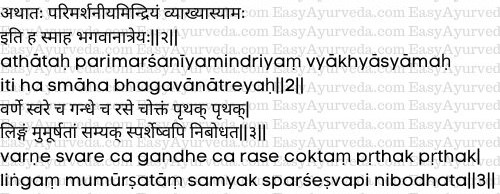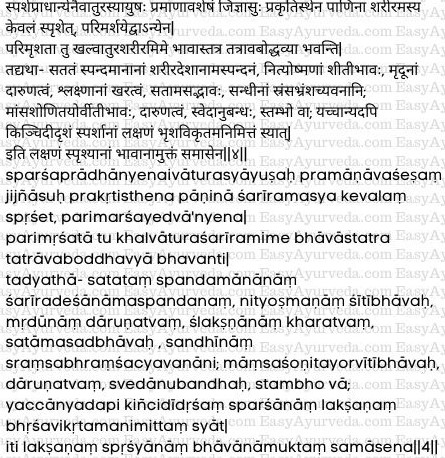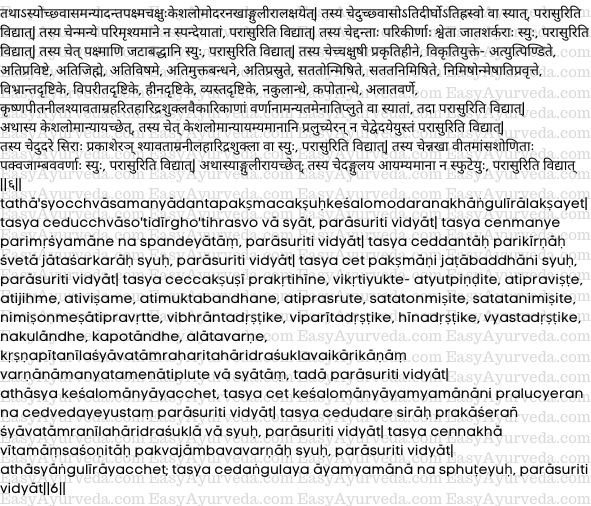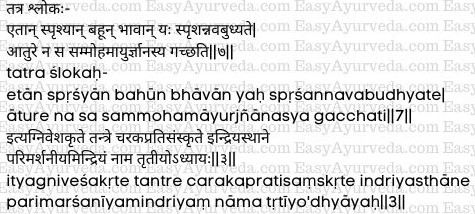Charaka Indriya Sthana 3rd Chapter Parimarshaniyam Indriyam
3rd chapter of Charaka Indriya sthana deals about the signs of imminent death indicated by touch. The chapter name is Parimarshaniyamindriyam.


Now we shall expound the chapter on the signs of imminent death as indicated by touch. Thus said lord Atreya. [1-2]
Signs of imminent death as indicated by complexions, voice, smell, and taste is already described separately. Those indicated by touch are being described now. [3]
Read – Bad Prognosis Based On Smell, Touch, Taste, Colour And Voice
Examination of moribund persons by touch

A physician who is desirous of ascertaining the life span of a given patient just on the basis of touch should touch the entire body of the patient with his palm. His hands should neither be too cold nor too hot and should have normal temperature.
If the hands of the physician are not healthy he shall get the patient touched and examined by some other person in whom he trusts. Even if the patient’s social customs do not permit the physician to touch the body of the patient or if the patient is of such status that the physician cannot touch the body of the patient (example – preceptor’s wife being a patient) he should get the patient touched and examined by some other person.
Read – Arishta Lakshanas – Ominous Signs And Symptoms Indicating Bad Prognosis
While touching the body of the patient, the below mentioned points need to be observed –
- Absence of movements (pulsation) in such of the organs of the body which move or pulsate constantly
- Coldness in organs which are normally (almost always) warm
- Hardness in soft organs
- Roughness in smooth organs
- Absence of organs which are normally present
- Major or minor dislocation of joints- downwards or side wards
- Excessive diminution of muscle tissue and blood
- Appearance of hardness in body parts
- Persistent sweating or its total absence
The above mentioned symptoms or similar other symptoms which reflect abnormal touch conditions without any appreciable cause are indicative of imminent death. Thus the tactile symptoms indicative of imminent death are briefly described. [4]
Read – Bad Prognosis Based On Premonitory Symptoms Of Disease – Purvarupiya Arishta
Details of examination

We shall now expound such symptoms in greater detail. If the feet, knees, buttocks, abdomen, sides of the chest, vertebral column, hands, neck, palate, lips and forehead of the patient are touched separately and if they are found wet, cold, rigid, hard or devoid of flesh and blood, it should be inferred that the life span of that individual has come to an end and he will die soon.
If in any person the ankles, knees, hips, anus, testicles, pains, umbilicus, shoulder, breasts, wrist joints, ribs, jaws, nose, ears, eyes, eyebrows and temples have become loose, scattered, displaced, dislocated or have become stiff and hard, then it should be predicted that the individual might face instantaneous death. [5]
Read – Prognosis Signs Based On The Messenger – Doota Adhishtita Arishta
The physician should carefully examine the exhalation, manya (region of carotid arteries, nape of the neck), teeth, eyelashes, eye, hair (of the head), loman (short hairs of the remaining parts of the body of the individual), abdomen, nails and fingers of the patients. The following conditions are indicative of imminent death of the patient:
- too long (deep) or short (shallow) breathe
- absence of pulsation in manya (nape of the neck / region of carotid arteries) when touched;
- teeth covered and adhered with dirt, is excessively white and covered with sugary particles
- matting of eyelashes
- eyes are devoid of natural characteristics and endowed with unnatural ones e.g. if they are excessively projected, withdrawn, slanted, uneven, loose, have excessive secretions, perpetually open/closed, very quick, frequent and continuous blinking, rolling, reverted, deficient or scattered vision, with morbidity of nakulandhya or blindness of mongoose i.e. they view everything as white during day time, with morbidity of kapotandhya (or the blindness of pigeon) i.e. they view everything as black during day time, fiery eyes – eyes look red like burning coal, endowed with excessively black, yellow, blue, darkish brown, coppery, green, turmeric, yellow or white color;
- hair of the head and loman (short hair of the remaining parts of the body of the individual) of the patient are pulled they come out easily with roots but do not cause pain
- veins on the abdomen are visible and have darkish brown, coppery, blue, turmeric, yellow or white colors or similar such colors
- nails are devoid of flesh and blood and black like ripe fruit of jambu (Syzygium cumini) and
- finger joints do not produce cracking sound even when bent and pressed [6]
Read – Eye Diseases Causes, Pathogenesis, Symptoms, Treatment, Herbs

To sum up:
The physician who can understand all the various tactile sensations by touch will seldom fail to ascertain the life span of the patient. [7]
Thus ends the third chapter on “the signs of imminent death as indicated by touch” of the indriya section of Agnivesa’s work as redacted by Caraka.








